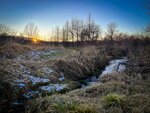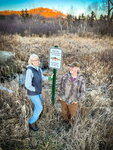

The title “Conservationists of the Year” has been given to Joey Esterline and Scott Giraud by the Monroe County Land Conservation Department. Nominated by their peers for their passionate work in conservation over the past two decades, the pair will receive honored recognition at the Monroe County Land Conservation Stewardship Award Banquet later this month.
Beginning with a focus on protecting a Class 1 trout stream (Coles Valley Creek) which runs through their land off Independence Rd. in the Town of Adrian, the duo has created vast swaths of prairie, mixed forest, and wetlands on land previously used for agriculture. The result is a stunning habitat for plants, insects, birds, fish, and mammals, including brook trout, monarch butterflies, and many more. Joey and Scott have developed a personal recipe for success, where Joey does much of the planning, and Scott enjoys bringing those plans into reality.
Local conservation agencies such as the Wisconsin Department of Natural Resources (WDNR), the US Department of Agriculture’s Natural Resources Conservation Service (NRCS), and the Monroe County Land Conservation Department (MCLCD), have provided everything from native seeds sources to expert guidance and resources in funding, and have been instrumental in their success.
Working with these agencies remains an important aspect of their future plans, including using sustainable logging overseen by a professional forester to restore oak savannah on the land. Aside from restoring habitat on their private lands, Scott and Joey also participate in their community in many ways, including their conservation and Farmers Market work as AlterNative Grounds. AlterNative Grounds seeks to nourish with organic homegrown food, educate with plant and conservation wisdom, and to bring back and protect our fragile Driftless ecosystems in a number of ways.
A Harmonious Place
Arriving at Joey Esterline’s and Scott Giraud’s “cabin,” one can't help but feel a sense of peace and harmony. The cabin is built into a hill, and three stories of glass windows provide both a majestic view and a way to conserve energy via passive solar heat. In front of the cabin, raised organic garden beds border the prairie and an old hayfield, which leads to wetlands and mixed forest.
Joey explained, “we have 39 acres here, and 75 acres down the bend. This is all hayfield up here. After taking some specific areas out of production on the hayfield we are seeing a return of two small wetlands, with sedges, rushes, asters, goldenrods, milkweed, and more. We have planted native buttonbush, wahoo, and larch to surround one of the new wetlands.”
Understanding a Trout Stream Leads to Restoring the Land Around It
A good truck is needed to cross the land to get to the other 75 acres. The Class 1 Trout Stream, “Cole’s Creek”, rambles through it, with crystal clear waters rushing over tresses of aquatic grasses. Joey gave voice to how, “Bob Micheel, Director of the Monroe County Land Conservation office is our neighbor. He is the one that let us know what a gem of a stream we have here, and he helped guide the restoration of the stream banks and lands around it, in order to protect it. We covered less than 10% of the cost for the streambank improvement project in exchange for a public fishing easement along the stream. How could we go wrong with that?”
For decades, the couple has been removing invasive plants and coaxing native plants along, with great results. The prairie has made a comeback, there is less erosion, and the stream is healthy. A symphony of sound and life has returned: brook trout, wood frogs, red headed woodpeckers, American woodcock, fishers, muskrat, monarchs and other butterflies, dragonflies, mink, and possibly even otters, are all among the wildlife which can be found here now.
An Oak Savannah Unfolds
Working closely with WDNR Forester/Ranger Clint Gilman, some of the land beyond the creek has been identified as Oak Savannah, which is home to burr oaks, lupine, leadplant, false indigo, butterfly weed and a number of other milkweed as well as a variety of prairie grasses. Currently, there is a great mix of woods, including hickory, maple, basswood and other hardwoods.
While this may seem like a good thing, in fact the towering stature of the maple, hickory and basswood make it difficult for the native oak to thrive. A human touch can help remedy this, with sustainable logging, under the supervision of a professional forester. Scott and Joey plan to work with a forester to choose a careful logger, who will sustainably harvest the valuable hardwoods in a win-win situation.
Monarch Prairie a Crowning Jewel
Still further up the way, the sturdy pick-up truck gets serious. Up, up, up the hill it climbs at an increasing slope until finally reaching an open flat ridge. Joey exclaimed, “All of this is monarch prairie!”
Esterline has been known for her decades of work in tagging the endangered monarchs, in order to track and better understand their migration patterns and survival rates. She went on to explain how Scott started preparing the land the year prior for a late fall planting of native prairie seeds this year. Planting prairie seeds in the fall will allow them to be cold stratified over the winter, better ensuring successful growth and hardiness and it helps the forbes (flowers) get a head start on the grasses. Now, it’s just a matter of waiting to see the results. Putting prairie on the ridge top also helps to anchor the soil and improve water quality. It’s all connected.
The NRCS website states that, “The NRCS offers technical and financial assistance to help landowners manage monarch habitat on farms, ranches, and forests. This assistance helps producers plan and implement a variety of conservation activities, or practices, that benefit the monarch, pollinators, and many other wildlife species.”
In response to taking part of this NRCS program, Joey reports that the opportunity in 2023 to plant this monarch pollinator prairie through the NRCS is significant to her work with Monarchs. In a couple of years, the breathtaking view of Driftless ridges and the setting sun will be crowned by a rainbow of color in the monarch prairie.
Organic Gardening Makes Good Sense
By choosing organic gardening, Joey and Scott can be confident about what they are putting on their table and selling at the Sparta Farmers Market. The couple also farms about 20 acres of hay land which they sell as small bale hay.
Joey grows a mix of heirloom dry beans, sweet corn, squash, herbs, broccoli, cauliflower, garlic, leeks, and zucchini. Esterline also sells her popular sauerkraut at the market, and sometimes grows additional native seedlings to share and sell. A visit to her AlterNative Grounds market stand in downtown Sparta during the market season promises a colorful display and great conversation on gardening, cooking, and conservation.
Community Involvement: An Important Piece of the Mosaic
Joey understands that local politics matter. She was elected as the District 15 County Board Supervisor in 2022. She can be found at town and county board meetings, on a variety of committees, working elections, and inspiring others to participate in their local government, too.
When she isn’t busy thus advocating for nature and sustainability, or working with Scott on their land, she can be found volunteering at places such as the Sparta Farmers Market Board, and/or presenting at various organizations. She is also a member of the Monroe County Invasive Species Working Group (MCISWG), and the Monroe County Deer Advisory Committee.
Scott volunteers with the Mississippi Valley Conservancy’s burn crew, MCISWG, and the Monroe County Chronic Wasting Disease Committee. Scott also consults and administers prescribed burns in the rural community where that is a viable solution for land management. Prescribed burns are a natural part of the prairie, providing minerals and nitrogen to the soil, thinning out invasive and woody plants, and even activating some native seeds.
Keeping and Sharing the Harmony of the Land Through Conservation
Joey and Scott have found a rhythm in their conservation work, which is a harmony of habitat restoration, organic gardening and farming, sustainable hunting and fishing, educating the public, and even living in a home which utilizes passive solar for heating in cold Wisconsin seasons. Their efforts have resulted in increased carbon sequestration, erosion control, wildlife habitat, and biodiversity, with ripple effects throughout the Driftless and beyond.
2024 Monroe County Land Stewardship Awards Banquet
Tickets Available for Award Banquet on Saturday, January 27, 2024, in Sparta, WI
The public is invited to the 2024 Monroe County Land Stewardship Awards Banquet. The dinner banquet will be held at 5pm at the Sparta American Legion on Saturday, January 27, 2024, with an evening meal, award presentations, youth poster contest recognition, and speakers. Tickets are $15 for adults, $10 for youth under 15, and can be purchased through the Land Conservation Department, 820 Industrial Drive, Suite 3, Sparta, WI. For additional information contact Tracy at 608-269-8973 or via Email: tracy.antonneau@co.monroe.wi.us
For more about the Land Conservation Stewardship Awards, please visit: https://www.co.monroe.wi.us/departments/land-conservation/stewardship-awards
To begin your own journey in conservation in Monroe County, visit: https://www.co.monroe.wi.us/departments/land-conservation
The US Fish & Wildlife Service explains why monarchs are so important: https://www.fws.gov/story/saving-one-butterfly-could-help-save-prairie
To get help creating pollinator habitat on your land, visit: https://www.nrcs.usda.gov/programs-initiatives/monarch-butterflies
To learn more about controlled/prescribed burns, visit: https://dnr.wisconsin.gov/topic/OpenBurning/BeforeYouBurn.html
Comments
No comments on this item Please log in to comment by clicking here